The Mystery and Melancholy of de Chirico
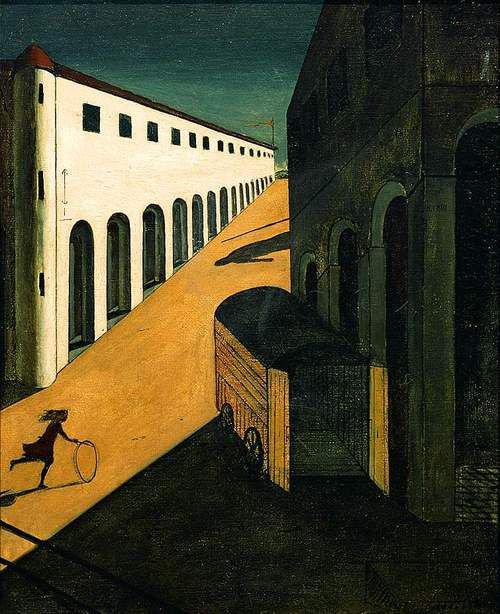 Mystery and Melancholy of a Street, 1913I am sorry to say that I never studied Metaphysical Art when I was at art school – I don’t even remember the term – but I must have been familiar with one of its founders even then, the artist Giorgio de Chirico (1888–1878), for his work has long been a favourite of mine.
Mystery and Melancholy of a Street, 1913I am sorry to say that I never studied Metaphysical Art when I was at art school – I don’t even remember the term – but I must have been familiar with one of its founders even then, the artist Giorgio de Chirico (1888–1878), for his work has long been a favourite of mine.
In Italian, Metaphysical Art translates as pittura metafisica, and de Chirico and fellow Italian painter Carlo Carrà (a leader of the Futurist movement as well) developed it in the second decade of the twentieth century. ‘Metaphysical art combined everyday reality with mythology, and evoked inexplicable moods of nostalgia, tense expectation, and estrangement.’ [Wikipedia]
 The Anguish of Departure, 1914
The Anguish of Departure, 1914
there is a disturbing and vaguely menacing mood in the dreamlike cityscapes.
When you look at de Chirico’s Metaphysical paintings (all produced over a decade, between 1909 and 1919), not only do they certainly evoke such moods, but you are not surprised to learn that they greatly influenced the Surrealists, for there is a disturbing and vaguely menacing mood in the dreamlike cityscapes. It is an effect achieved in part through the juxtaposition of tiny figures against monumental architecture.
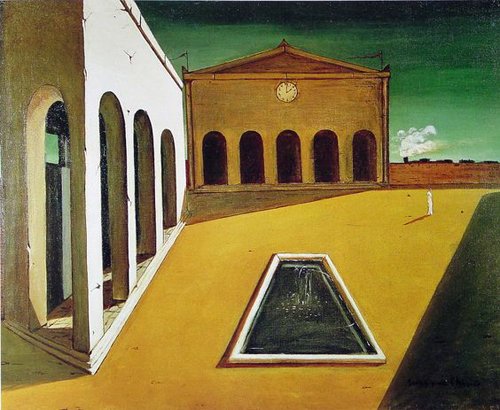 Delights of the Poet, 1913De Chirico was inspired by the writings of Nietzsche, ‘with its suggestions of unseen auguries beneath the appearance of things’, which translated into his own unexpected responses to quotidian surroundings and objects. He wrote in 1909 about the ‘host of strange, unknown and solitary things that can be translated into painting ... What is required above all is a pronounced sensitivity’— and both imagination and inclination I would think, to look beyond the surface of accustomed sights, such as the archways and piazzas of Turin where he spent a few days while on his way to Paris in 1911.
Delights of the Poet, 1913De Chirico was inspired by the writings of Nietzsche, ‘with its suggestions of unseen auguries beneath the appearance of things’, which translated into his own unexpected responses to quotidian surroundings and objects. He wrote in 1909 about the ‘host of strange, unknown and solitary things that can be translated into painting ... What is required above all is a pronounced sensitivity’— and both imagination and inclination I would think, to look beyond the surface of accustomed sights, such as the archways and piazzas of Turin where he spent a few days while on his way to Paris in 1911.
 The Agonizing Morning, 1912His deserted cityscapes of saturated colour – inspired by the ‘metaphysical aspect’ of Turin, especially its architecture – depict strange streets laid out with illogical perspectives, littered with strange objects, all in the high contrast lighting of the bright Mediterranean sun that produced such long shadows. While he focussed first on these, he gradually moved on to explore cluttered interiors that were sometimes occupied by surreal figures, faceless hybrids of statuary and wooden mannequins.
The Agonizing Morning, 1912His deserted cityscapes of saturated colour – inspired by the ‘metaphysical aspect’ of Turin, especially its architecture – depict strange streets laid out with illogical perspectives, littered with strange objects, all in the high contrast lighting of the bright Mediterranean sun that produced such long shadows. While he focussed first on these, he gradually moved on to explore cluttered interiors that were sometimes occupied by surreal figures, faceless hybrids of statuary and wooden mannequins.
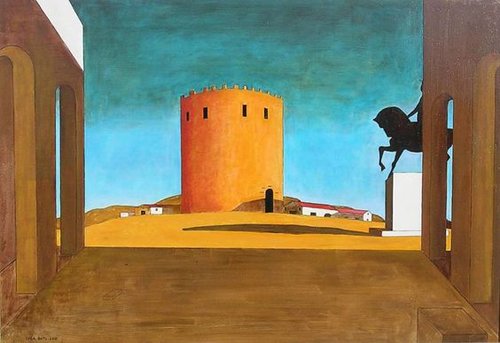 The Red Tower, 1913
The Red Tower, 1913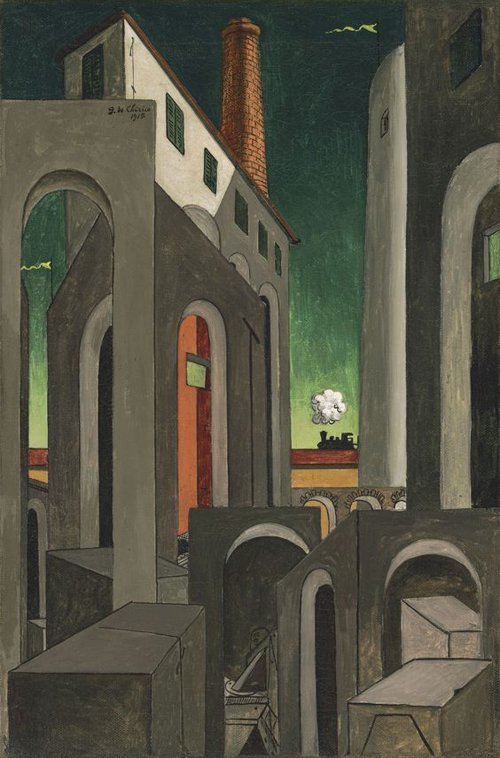 Fleeing Horse, 1917But it is the cityscapes that I love the most, for their disquieting sense of mystery and emptiness, a kind of visual poetry. I would like to run into those paintings, just like the girl with the hoop in Mystery and Melancholy of a Street, to explore those empty streets and discover what is hiding around the corner.
Fleeing Horse, 1917But it is the cityscapes that I love the most, for their disquieting sense of mystery and emptiness, a kind of visual poetry. I would like to run into those paintings, just like the girl with the hoop in Mystery and Melancholy of a Street, to explore those empty streets and discover what is hiding around the corner.
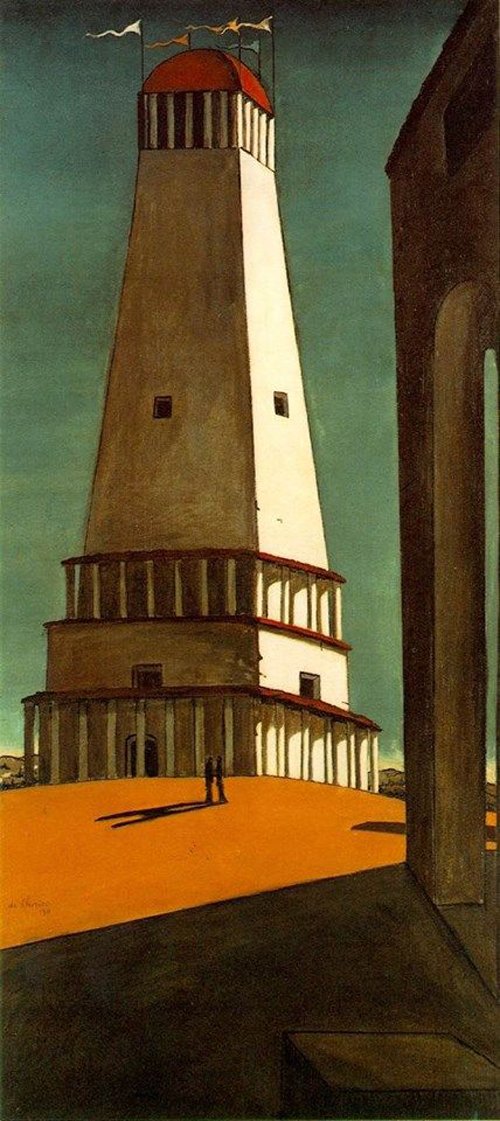 The Nostalgia of the Infinite, 1913
The Nostalgia of the Infinite, 1913
All images found on Pinterest
Alice’s Adventures on Film
 Tatiana's adventures inside a sandwich boardOne of my favourite childhood books was Lewis Carroll’s Alice in Wonderland. So I was very much looking forward to seeing the Wonderland exhibition at the Australian Centre of the Moving Image (ACMI), which explores the many adventures of Carroll’s famous story on film.
Tatiana's adventures inside a sandwich boardOne of my favourite childhood books was Lewis Carroll’s Alice in Wonderland. So I was very much looking forward to seeing the Wonderland exhibition at the Australian Centre of the Moving Image (ACMI), which explores the many adventures of Carroll’s famous story on film.
 The disorienting mirrored Hallway of Doors
The disorienting mirrored Hallway of Doors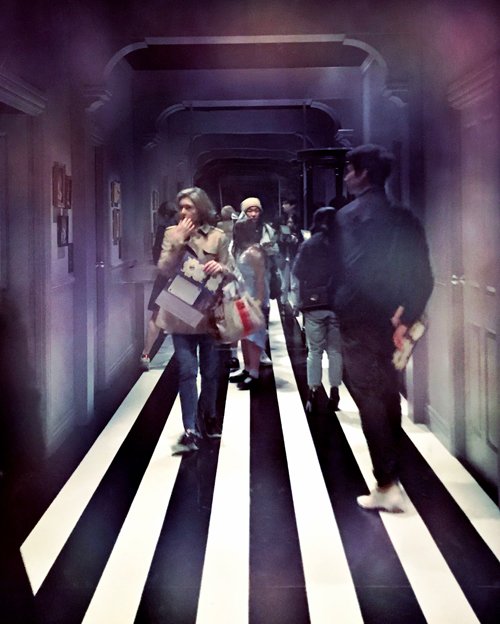 Looking through the two-way mirror into the Hallway of DoorsBeginning with the Hallway of Doors (enter by the smallest door, no matter how old you are), is a series of fantastical rooms, with names such as ‘The Pool of Tears’, ‘Looking Glass House’ and ‘A Mad Tea Party’. On show is charming footage from the late nineteenth century to the multitude of iterations produced in the century since, as well as a plethora of other material such as Charles Dodgson’s original concept drawings, magic lantern projections, vintage posters, animation cels, puppets, props and costumes.
Looking through the two-way mirror into the Hallway of DoorsBeginning with the Hallway of Doors (enter by the smallest door, no matter how old you are), is a series of fantastical rooms, with names such as ‘The Pool of Tears’, ‘Looking Glass House’ and ‘A Mad Tea Party’. On show is charming footage from the late nineteenth century to the multitude of iterations produced in the century since, as well as a plethora of other material such as Charles Dodgson’s original concept drawings, magic lantern projections, vintage posters, animation cels, puppets, props and costumes.
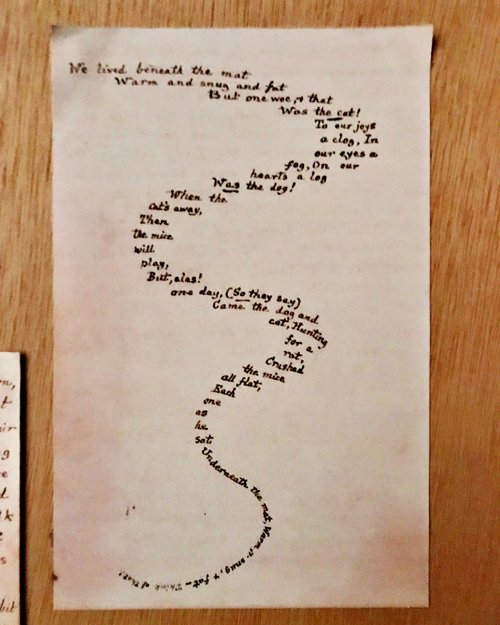 This was always my favourite page in the book when I was very little, so I was thrilled to see Charles Dodgson's original drawing, c1862–64The exhibition is immersive from the get go. On entrance, each attendee is given an ‘enchanted Lost Map of Wonderland’ that unlocks additional surprises with the aid of digital scanners in different rooms of the exhibition – if you could get past the kids hovering over the scanners.
This was always my favourite page in the book when I was very little, so I was thrilled to see Charles Dodgson's original drawing, c1862–64The exhibition is immersive from the get go. On entrance, each attendee is given an ‘enchanted Lost Map of Wonderland’ that unlocks additional surprises with the aid of digital scanners in different rooms of the exhibition – if you could get past the kids hovering over the scanners.
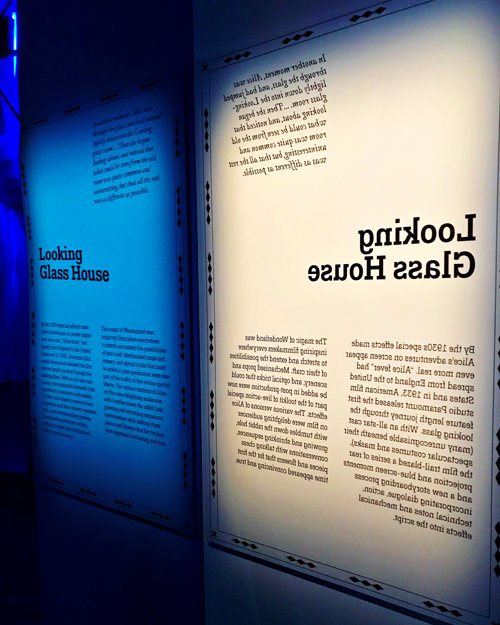 Looking Glass House; the exhibition's curation is thoughtful and thorough, and the design is clever and entertaining for young and old
Looking Glass House; the exhibition's curation is thoughtful and thorough, and the design is clever and entertaining for young and old 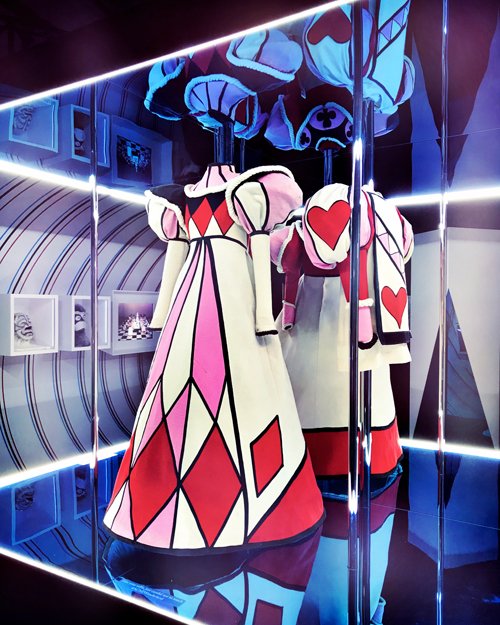 Queen's costumes in Looking Glass HouseThere are also several video installations, and my favourite was at the end, a montage of footage from film, television and advertising showcasing how the story of Alice has entered and utterly saturated popular culture to the present day. I could not help picturing how astonished and gratified Dodgson would be if he could see how far in time and space his story has reached.
Queen's costumes in Looking Glass HouseThere are also several video installations, and my favourite was at the end, a montage of footage from film, television and advertising showcasing how the story of Alice has entered and utterly saturated popular culture to the present day. I could not help picturing how astonished and gratified Dodgson would be if he could see how far in time and space his story has reached.
If you are in Melbourne, the exhibition is running at ACMI every day of the week until 7 October, and is a must-see.
 Clocks
Clocks Inside the video installation of A Mad Hatter's Tea Party
Inside the video installation of A Mad Hatter's Tea Party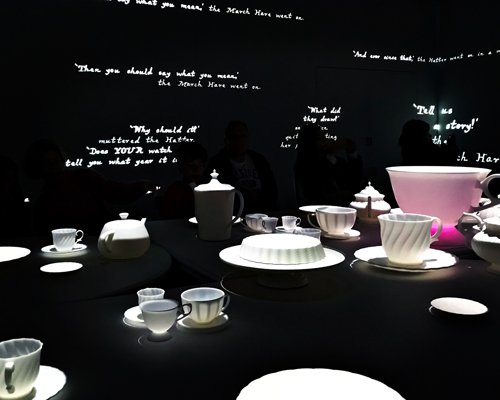 Inside the video installation of A Mad Hatter's Tea Party
Inside the video installation of A Mad Hatter's Tea Party
A Match Made in Wonderland
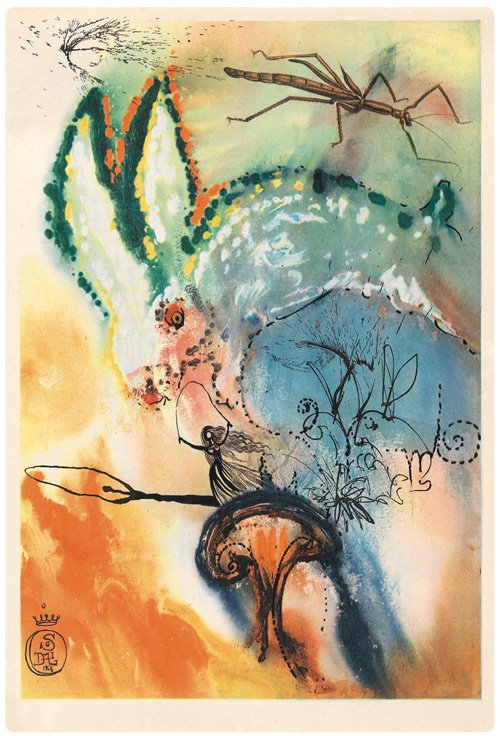 While I am not a big fan of Salvador Dalí’s work, I must admit that pairing him with Lewis Carroll’s Alice’s Adventures in Wonderland (a childhood favourite of mine) was a stroke of brilliance. An editor at Random House commissioned the artist to illustrate an exclusive edition of the book in the 1960s, with all copies signed by the artist.
While I am not a big fan of Salvador Dalí’s work, I must admit that pairing him with Lewis Carroll’s Alice’s Adventures in Wonderland (a childhood favourite of mine) was a stroke of brilliance. An editor at Random House commissioned the artist to illustrate an exclusive edition of the book in the 1960s, with all copies signed by the artist.
 The book celebrated its 150th anniversary two years ago, and this edition was was published for the public by Princeton University Press. Currently in Melbourne, the Australian Centre of the Moving Image is presenting a world premiere exhibition celebrating the tale as it has appeared on film, so I’m keeping my fingers crossed that this book might be amongst the merchandise on sale.
The book celebrated its 150th anniversary two years ago, and this edition was was published for the public by Princeton University Press. Currently in Melbourne, the Australian Centre of the Moving Image is presenting a world premiere exhibition celebrating the tale as it has appeared on film, so I’m keeping my fingers crossed that this book might be amongst the merchandise on sale.
Here is the phantasmagorical result of Dalí’s reimaginings of the famous tale. Read more here.
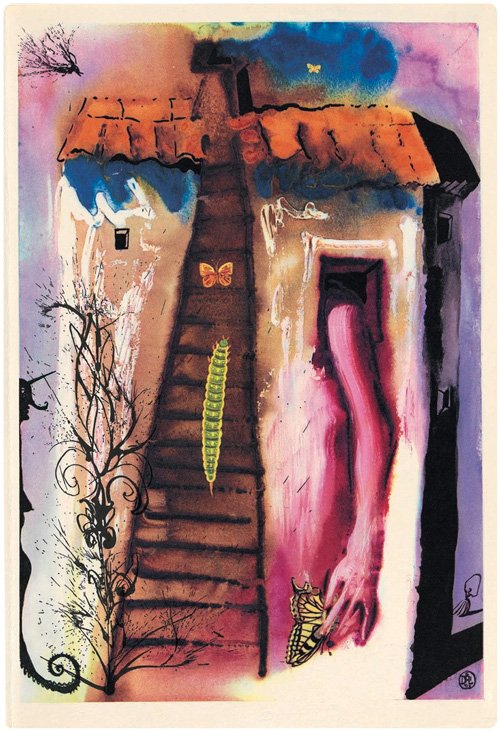
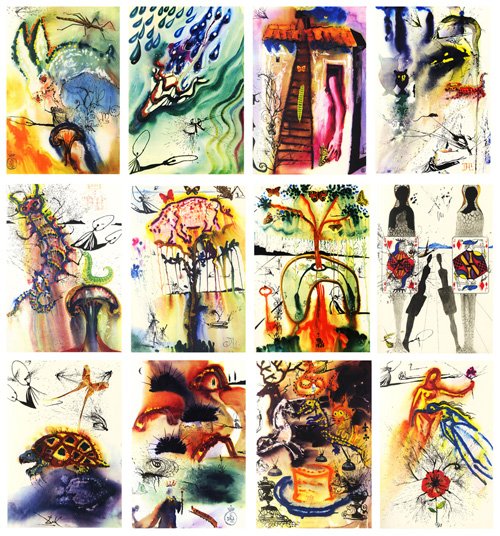
Hanging Poems
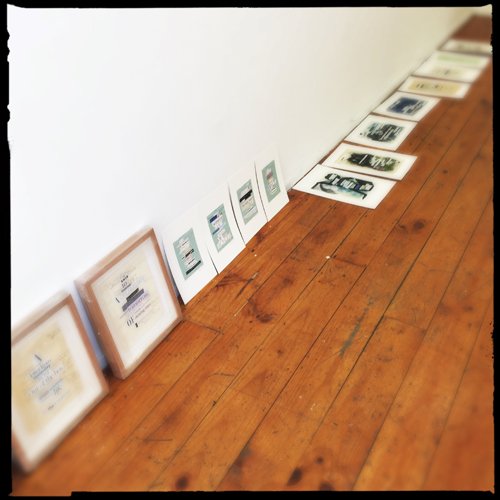 Getting ready to hangLast Thursday night I hung my exhibition at Brunswick Street Gallery. This is only my second group exhibition, and the first time I hung my own work. The method is pretty easy, and it was very satisfying to complete the task. Seeing how many pieces I had (I had originally intended to hang them all in two rows, and was prepared to pull some if it was too crowded) the curator generously allowed me to take up more space than originally allocated, which was fantastic.
Getting ready to hangLast Thursday night I hung my exhibition at Brunswick Street Gallery. This is only my second group exhibition, and the first time I hung my own work. The method is pretty easy, and it was very satisfying to complete the task. Seeing how many pieces I had (I had originally intended to hang them all in two rows, and was prepared to pull some if it was too crowded) the curator generously allowed me to take up more space than originally allocated, which was fantastic.
 Prints pinned
Prints pinned
The works were printed by Karl at Lantern Printing, on cotton rag archival paper using archival pigment inks. They came up beautifully, and the crumpled antique papers look so realistic and three-dimensional. Two originals were float-mounted in oak frames, by Leigh at Auguste Clown Gallery.
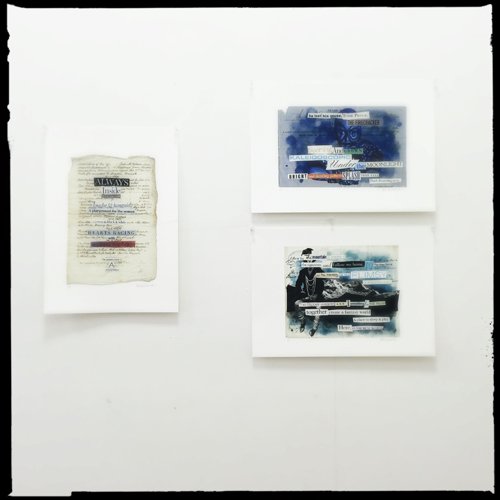 Works on exhibit include prints of hard copy originals, and prints of entirely digital artworks Opening night was on Friday, and unfortunately I was far too busy talking to guests to remember to take any photos – tsk! It was a fun evening, despite a few nerves at the start. I was hoping to overhear viewers’ responses, but alas, again, too busy talking to eavesdrop!
Works on exhibit include prints of hard copy originals, and prints of entirely digital artworks Opening night was on Friday, and unfortunately I was far too busy talking to guests to remember to take any photos – tsk! It was a fun evening, despite a few nerves at the start. I was hoping to overhear viewers’ responses, but alas, again, too busy talking to eavesdrop!
 Frames hung (not without errors prior to success!)At the conclusion of the show (two weeks from now), I will create an online gallery here for viewing. Most of the pieces on show are prints of traditional (hard copy) collages, but you can check out my digital pieces in the Random Poetry galleries.
Frames hung (not without errors prior to success!)At the conclusion of the show (two weeks from now), I will create an online gallery here for viewing. Most of the pieces on show are prints of traditional (hard copy) collages, but you can check out my digital pieces in the Random Poetry galleries.
 The works are printed on cotton rag archival paper
The works are printed on cotton rag archival paper
Layering Dreams
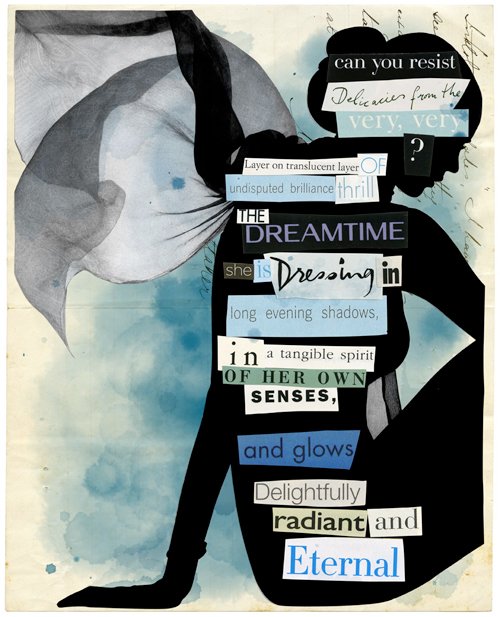 I am excited to share the news that I am taking part in a group exhibition at Brunswick Street Gallery called Read What You Look At, which opens this Friday night, and runs for two weeks.
I am excited to share the news that I am taking part in a group exhibition at Brunswick Street Gallery called Read What You Look At, which opens this Friday night, and runs for two weeks.
Although it is not my first group exhibition, it is the biggest one I’m showing in, with fourteen pieces of my ‘random poetry’ mixed-media collages on view. The series is entitled Layering Dreams, and is – you guessed it – all about dreams, sleeping, and waking.
Here is an abridged version of my artist’s statement:
From a very young age, I was captivated with telling stories through both words and pictures, often drawing and writing on found paper. At art college after studying the Dadaists, I became interested in writing poetry by reassembling random words. Recycling my magazine collection, I created a pool from which I could pull words to compile into ‘random poems’.
Always interested in dreams, and the surrealism intertwined with hidden meanings, this method of writing poetry appealed to me. Naturally, I choose words that I find appealing, but sometimes I deliberately choose ones that I don’t. This strange combination contributes to the elusive mood of Layering Dreams, often with unexpected results.
 Sometimes a poem just starts with two or three words, and I slowly build on those. The poems are engaging and easy to read not only because of their brevity, but because of how they look. The fonts and colours culled from so many different sources interact with one another visually, encouraging the viewer to also ‘look at what they read’.
Sometimes a poem just starts with two or three words, and I slowly build on those. The poems are engaging and easy to read not only because of their brevity, but because of how they look. The fonts and colours culled from so many different sources interact with one another visually, encouraging the viewer to also ‘look at what they read’.
Returning to my roots of acquiring used paper (I’d pinch my sisters’ papers from their school folders!), I’ve sourced antique papers from the late nineteenth century to the 1950s, to use as supports for the collages. As well as traditional (hard copy) collages using only words, I also create digital works, combining scanned words and images cut from magazines with digital ink.
These many layers of ephemera, words, and pictures combine to evoke the otherworldly nature of dreams.
If you happen to be in Melbourne, I’d love for you to come and check them out in person!


